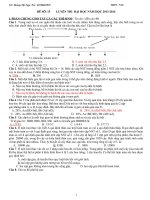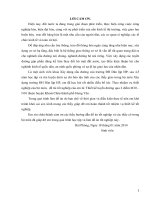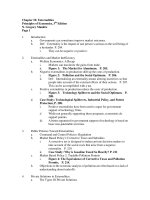VSICM6 m10 hostscalability
Bạn đang xem bản rút gọn của tài liệu. Xem và tải ngay bản đầy đủ của tài liệu tại đây (292.56 KB, 24 trang )
Host Scalability
Module 10
© 2015 VMware Inc. All rights reserved.
You Are Here
1. Course Introduction
7. Virtual Machine Management
2. Software-Defined Data Center
8. Resource Management and
3. Creating Virtual Machines
4. vCenter Server
5. Configuring and Managing
Virtual Networks
6. Configuring and Managing
Virtual Storage
Monitoring
9. vSphere HA and vSphere Fault
Tolerance
10. Host Scalability
11. vSphere Update Manager and
Host Maintenance
12. Installing vSphere Components
VMware vSphere: Install, Configure, Manage
© 2015 VMware Inc. All rights reserved.
10-2
Importance
As you scale your VMware vSphere® environment, you must be aware
of the vSphere features and functions that will help you manage the
hosts in your environment.
VMware vSphere: Install, Configure, Manage
© 2015 VMware Inc. All rights reserved.
10-3
Learner Objectives
By the end of this module, you should be able to meet the following
objectives:
• Describe the functions of a VMware vSpheređ Distributed Resource
Scheduler cluster
ã Create a vSphere DRS cluster
ã View information about a vSphere DRS cluster
• Remove a host from a vSphere DRS cluster
VMware vSphere: Install, Configure, Manage
© 2015 VMware Inc. All rights reserved.
10-4
vSphere DRS Cluster Prerequisites
vSphere DRS works best when the virtual machines meet VMware
vSphere® vMotion® migration requirements.
To use vSphere DRS for load balancing, the hosts in the cluster must be
part of a vSphere vMotion migration network.
• If not, vSphere DRS can still make initial placement recommendations.
To use shared storage, configure all hosts in the cluster:
• Volumes must be accessible by all hosts.
• Volumes must be large enough to store all virtual disks for your virtual
machine.
VMware vSphere: Install, Configure, Manage
© 2015 VMware Inc. All rights reserved.
10-5
vSphere DRS Cluster Settings: Automation Level
Configure the automation level for the initial placement of virtual
machines and dynamic balancing while virtual machines are running.
Automation Level Settings
Migration threshold guides selection
of virtual machines for migration.
VMware vSphere: Install, Configure, Manage
© 2015 VMware Inc. All rights reserved.
10-6
Other Cluster Settings: Swap File Location for vSphere DRS
Store the virtual machine’s swap file with the virtual machine or in a
specified datastore.
VMware recommends that you store the swap file in the same directory
as the virtual machine.
VMware vSphere: Install, Configure, Manage
© 2015 VMware Inc. All rights reserved.
10-7
vSphere DRS Cluster Settings: Virtual Machine Affinity
vSphere DRS affinity rules
specify that selected virtual
machines be placed either
on
the same host (affinity) or on
separate hosts (anti-affinity).
Affinity rules:
• Use for multi-virtual machine
systems where virtual
machines communicate
heavily with one another.
Anti-affinity rules:
Options:
• Keep Virtual Machines Together
• Separate Virtual Machines
• Virtual Machines to Hosts
• Use for multi-virtual machine
systems where load balance
or high availability is desired.
VMware vSphere: Install, Configure, Manage
© 2015 VMware Inc. All rights reserved.
10-8
vSphere DRS Cluster Settings: DRS Groups
DRS groups are used in
defining VM-Host affinity
rules.
Types of DRS groups:
• A group of virtual machines
• A group of hosts
A virtual machine can belong
to multiple virtual machine
DRS groups.
A host can belong to multiple
host DRS groups.
VMware vSphere: Install, Configure, Manage
© 2015 VMware Inc. All rights reserved.
10-9
vSphere DRS Cluster Settings: VM-Host Affinity Rules
A VM-Host affinity rule:
• Specifies an affinity
relationship between a virtual
machine DRS group and a
host DRS group
• Is either a required rule or a
preferential rule
Other options:
Must run on hosts in group,
Must Not run on hosts in group,
Should Not run on hosts in group
VMware vSphere: Install, Configure, Manage
© 2015 VMware Inc. All rights reserved.
10-10
VM-Host Affinity Rule: Preferential
A preferential rule is softly enforced and can be violated if necessary.
Example: Separate virtual machines on different blade systems.
vSphere DRS Cluster
Group A
X
Group B
X
Blade Chassis A
Blade Chassis B
VMware vSphere: Install, Configure, Manage
© 2015 VMware Inc. All rights reserved.
10-11
VM-Host Affinity Rule: Required
A required rule is strictly enforced and can never be violated.
Example: Enforce host-based ISV licensing.
vSphere DRS Cluster
Group A
X
X
ISV-Licensed
VMware vSphere: Install, Configure, Manage
© 2015 VMware Inc. All rights reserved.
10-12
vSphere DRS Cluster Settings: Automation at the Virtual Machine Level
You can customize the automation level for individual virtual machines in
a cluster to override the automation level set on the entire cluster.
VMware vSphere: Install, Configure, Manage
© 2015 VMware Inc. All rights reserved.
10-13
Adding a Host to a Cluster
When adding a host or moving a host into a vSphere DRS cluster, you
can keep the resource pool hierarchy of the existing host.
• If vSphere DRS is not enabled, host resources pools are lost.
For example, add sc-quail04 to Lab Cluster.
When adding the host, choose to create a
resource pool for this host’s virtual
machines and resource pools.
VMware vSphere: Install, Configure, Manage
© 2015 VMware Inc. All rights reserved.
10-14
Viewing vSphere DRS Cluster Information
The cluster Summary tab provides information specific to vSphere DRS.
Clicking the vSphere DRS link on the Monitor tab displays CPU and
memory utilization per host.
VMware vSphere: Install, Configure, Manage
© 2015 VMware Inc. All rights reserved.
10-15
Viewing vSphere DRS Recommendations
The DRS tab displays information about the vSphere DRS
recommendations made for the cluster, the faults that occurred in
applying such recommendations, and the history of vSphere DRS
actions.
Refresh recommendations.
Apply a subset of
recommendations.
Apply all
recommendations.
VMware vSphere: Install, Configure, Manage
© 2015 VMware Inc. All rights reserved.
10-16
Monitoring Cluster Status
View the inventory hierarchy for the cluster state.
You can view the cluster’s Tasks and Events tabs for more information.
VMware vSphere: Install, Configure, Manage
© 2015 VMware Inc. All rights reserved.
10-17
Maintenance Mode and Standby Mode
To service a host in a cluster, for example, to install more memory, or
remove a host from a cluster, you must place the host in maintenance
mode:
• Virtual machines on the host should be migrated to another host or shut down.
• You cannot power on virtual machines or migrate virtual machines to a host
entering maintenance mode.
• While in maintenance mode, the host does not allow you to deploy or power on
a virtual machine.
When a host is placed in standby mode, it is powered off:
• This mode is used by VMware vSphere® Distributed Power Management™ to
optimize power usage.
VMware vSphere: Install, Configure, Manage
© 2015 VMware Inc. All rights reserved.
10-18
Removing a Host from the vSphere DRS Cluster
Before removing a host
from a vSphere DRS
cluster, consider the
following issues:
• The resource pool
hierarchy remains with the
cluster.
• Because a host must be in
maintenance mode, all
virtual machines running on
that host are powered off.
• The resources available for
the cluster decrease.
VMware vSphere: Install, Configure, Manage
© 2015 VMware Inc. All rights reserved.
10-19
Improving Virtual Machine Performance Methods
Fine
Use network
traffic shaping.
Modify the virtual
machine’s CPU and memory
reservations.
Modify the resource pool’s CPU and
memory limits and reservations.
Broad
Use NIC teaming.
Use storage multipathing.
Use a vSphere DRS cluster.
VMware vSphere: Install, Configure, Manage
© 2015 VMware Inc. All rights reserved.
10-20
Using vSphere HA with vSphere DRS
Reasons why VMware vSphere® High Availability might not be able to
fail over virtual machines:
• vSphere HA admission control is disabled.
• Required VM-Host affinity rule prevents vSphere HA from failing over.
• Sufficient aggregated resources exist, but they are fragmented across hosts.
In such cases, vSphere HA uses vSphere DRS to try to adjust the cluster
by migrating virtual machines to defragment the resources.
VMware vSphere: Install, Configure, Manage
© 2015 VMware Inc. All rights reserved.
10-21
Lab 22: Implementing a vSphere DRS Cluster
Implement a vSphere DRS cluster
1. Create a Load Imbalance
2. Create a vSphere DRS Cluster
3. Verify Proper vSphere DRS Cluster Functionality
4. Create, Test, and Disable a VM-VM Affinity Rule
5. Create, Test, and Disable an Anti-Affinity Rule
6. Create, Test, and Disable a VM-Host Affinity Rule
VMware vSphere: Install, Configure, Manage
© 2015 VMware Inc. All rights reserved.
10-22
Review of Learner Objectives
You should be able to meet the following objectives:
ã Describe the functions of a VMware vSpheređ Distributed Resource
Scheduler™ cluster
• Create a vSphere DRS cluster
• View information about a vSphere DRS cluster
• Remove a host from a vSphere DRS cluster
VMware vSphere: Install, Configure, Manage
© 2015 VMware Inc. All rights reserved.
10-23
Key Points
• vSphere DRS clusters provide automated resource management for multiple
VMware ESXi™ hosts.
• vSphere DRS works best if the virtual machines meet vSphere vMotion
migration requirements.
Questions?
VMware vSphere: Install, Configure, Manage
© 2015 VMware Inc. All rights reserved.
10-24









